You know what’s truly fascinating? Our insatiable appetite for data. Everything we do now, from streaming our favorite shows to asking AI for creative ideas, generates mountains of information. And all that data, well, it needs a home. Not just any home, mind you, but these enormous, incredibly complex structures we call data centers. Building them? That’s a whole different ballgame, and honestly, it’s one of the most high-stakes puzzles in modern construction.
For a construction CEO or owner, this boom in data center projects sounds like a golden ticket. And it often is! But let’s be real, these aren’t typical construction jobs. The sheer complexity, the breakneck speed, the budget sensitivity—it’s enough to make even the most seasoned professional lose a bit of sleep. Trying to manage such projects with old-school methods, like spreadsheets and endless email chains, is pretty much an invitation for chaos.
The Unique Animal That Is Data Center Construction
So, what makes building a data center so different from, say, an office building or a warehouse? Think about it this way: you’re not just putting up four walls and a roof. You’re essentially constructing a gigantic, precision-engineered machine. Every single component, from the massive electrical systems to the intricate cooling units and server rack placements, has to be perfect. A tiny mistake in the sequencing of these specialized trades can quickly unravel the entire project, causing delays that echo through the budget.
These projects often operate on incredibly tight timelines, sometimes under a year. When you’re dealing with investments of this magnitude, every single day of delay can translate into millions in lost revenue. It’s a relentless pace, coordinating a small army of specialists, managing global supply chains for critical components, and ensuring every step meets uncompromising quality standards. It’s like conducting an orchestra where every musician is playing a unique, vital part, and every note has to be flawless.
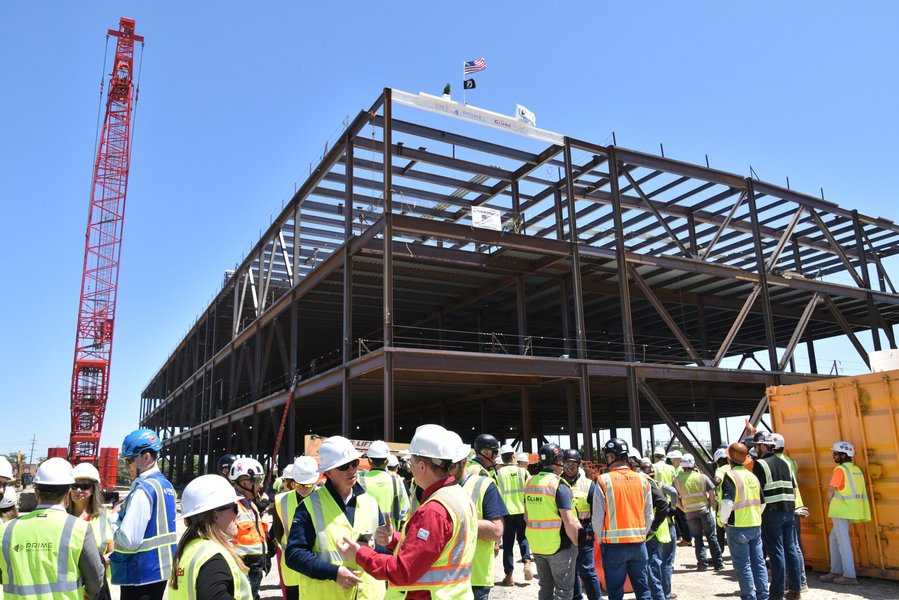
A glimpse into the massive scale of a data center construction site.
Why Precision and Reliability Reign Supreme
Unlike a standard office block where aesthetics might take center stage, data centers are all about raw power, consistent cooling, and uninterrupted operation. We’re talking about 24/7 uptime, so everything, from the initial architectural drawings to the very last cable laid, requires meticulous planning and execution. It’s a place where functionality and reliability aren't just preferences; they're absolute necessities.
This is precisely why traditional construction methods, those with their scattered documents and siloed communications, just won't cut it anymore. Honestly, trying to wrangle a data center build with outdated tools is a bit like attempting to build a spaceship with just a hammer and nails. You need something that pulls everything together, something that gives you the complete picture, not just disconnected fragments.
Harnessing the Power of Construction Management Software
This is where modern construction management software truly shines, especially for these colossal, complex projects. Imagine having a central nervous system for your entire operation, a hub where everyone—from the project manager on-site to the CEO in the office—gets real-time updates. No more chasing down emails, no more deciphering cryptic notes; everything is right there, clear as day.
Such a system becomes the single source of truth for all stakeholders. Real-time collaboration isn't just a nice-to-have; it's absolutely non-negotiable. It helps streamline workflows, connecting all the moving parts that often cause delays. Cloud-based access means everyone has the most up-to-date information, anytime, anywhere. This holistic approach proves invaluable for today's demanding data center builds.
Essential Software Capabilities for Data Centers
So, what should you really look for in a platform that can tame this beast? It’s not about flashy features, but rather core functionalities that genuinely get the job done. Here are some of the critical areas where effective software makes a profound difference:
Streamlined Planning and Scheduling
Scheduling in data center construction isn't just about simple Gantt charts. It needs to be dynamic, resource-loaded, and capable of adapting to constant changes. Tools that offer multi-tier timelines, automate task assignments, and integrate material delivery schedules can literally make or break a project. In a domain where every second counts, this capability is priceless. Specialized tools like Touchplan are known for their planning prowess in these complex jobs. Some even use AI, like ALICE, to run scenarios and optimize construction paths long before ground is even broken. The goal is always to anticipate problems, not merely react to them.
Rigorous Financial Control
You need ruthless financial control. I’m talking about real-time cost tracking that directly links to field operations and accounting systems. You need to understand the financial ripple effect of a delay the very moment it occurs, not weeks or months later. This deep financial integration is a game-changer. It means you can plan budgets meticulously, track job costs precisely, manage procurement effectively, and forecast margins with confidence.
Comprehensive Procurement Management
Managing procurement for specialized components like switchgear, CRACs (Computer Room Air Conditioners), busways, and structured cabling involves complex packages with approvals, specific delivery windows, and detailed cost codes. Effective software ensures that any variations flow directly into forecasts, rather than getting lost in a sea of emails. Knowing what you have, where it is, and when it’s needed prevents countless headaches and costly delays.
Archdesk: Your Command Center for Data Center Construction
Now, when it comes to software that truly grasps the intricacies of construction, especially for projects as demanding as data centers, you really want a system that provides complete overview and control. That’s precisely what Archdesk offers. It’s designed as a comprehensive business management platform, not just a fragmented tool for specific tasks.
Think of Archdesk as the central nervous system for your construction company. It seamlessly connects project management—including scheduling, document control, and task management—directly to your financials, procurement, and even equipment tracking. This isn't just about managing a single data center project; it's about managing your entire portfolio from one unified dashboard. You gain a holistic view that other disconnected systems struggle to piece together. This cohesion eliminates the data silos that so often lead to miscommunication and expensive errors, giving you the clarity needed to make confident, strategic decisions rather than educated guesses.
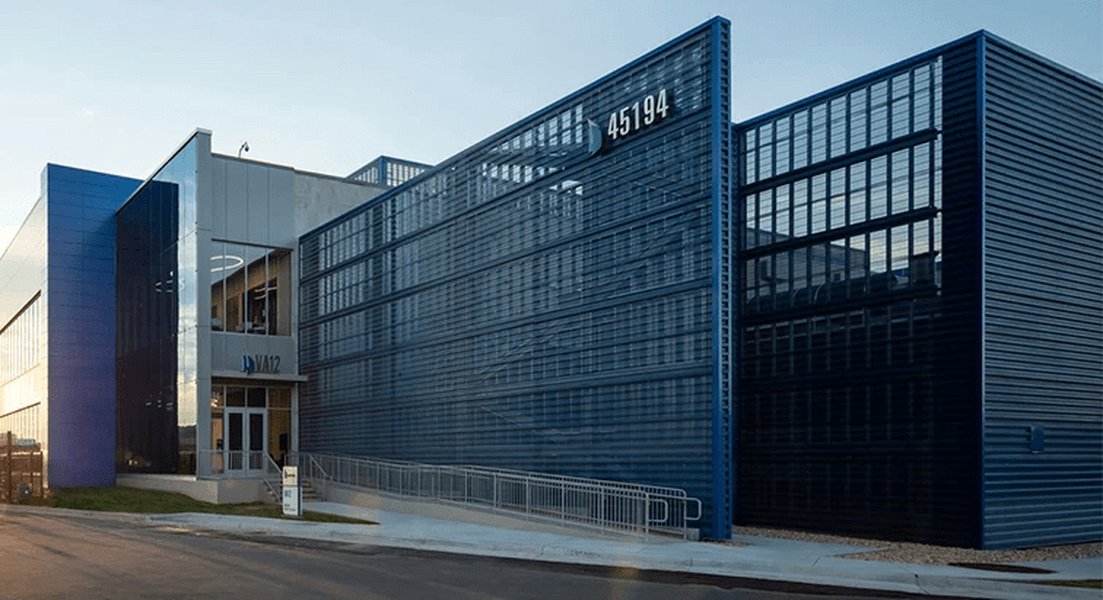
Precast concrete data center construction, highlighting modular efficiency.
The Archdesk Advantage: From Field to Finance
Archdesk truly distinguishes itself by linking live project delivery directly to financial control, something every CEO and owner cares deeply about. It offers an integrated approach that sets it apart from many competitors.
Connecting Project Progress to Financial Realities
With Archdesk, you can manage everything from bids and estimations to detailed schedules and robust cost controls. Imagine real-time cost tracking, precise budget forecasting, and powerful procurement management all in one place. That kind of financial visibility is crucial for profitability, especially with the enormous investments involved in data centers. It’s built for contractors, subcontractors, and those high capital expenditure projects where every penny counts.
The system excels at helping you track test packs, ITPs (Inspection and Test Plans), punch lists, and closeout artifacts. This ensures that commissioning—often a chaotic phase—doesn't devolve into a frantic paperwork hunt. While specialized commissioning tools might be used, Archdesk can house the contract, cost, and deliverables context, ensuring that signoff accurately matches scope and spend.
Comparing Archdesk with Other Solutions
When you look at the landscape of construction management software, you’ll find many players. Procore, for example, offers broad project tooling, which is great for general oversight. Autodesk Construction Cloud (ACC) shines with its integration of models and design handoffs, particularly for BIM. However, for data center contractors and owners who demand strong cost control alongside powerful delivery tools, all integrated into one platform, Archdesk genuinely stands out.
It’s the difference between having a collection of excellent individual players and having a championship team that works together seamlessly. Archdesk brings finance and operations together without requiring you to bolt on another Enterprise Resource Planning (ERP) system, making it a more cohesive and efficient solution.
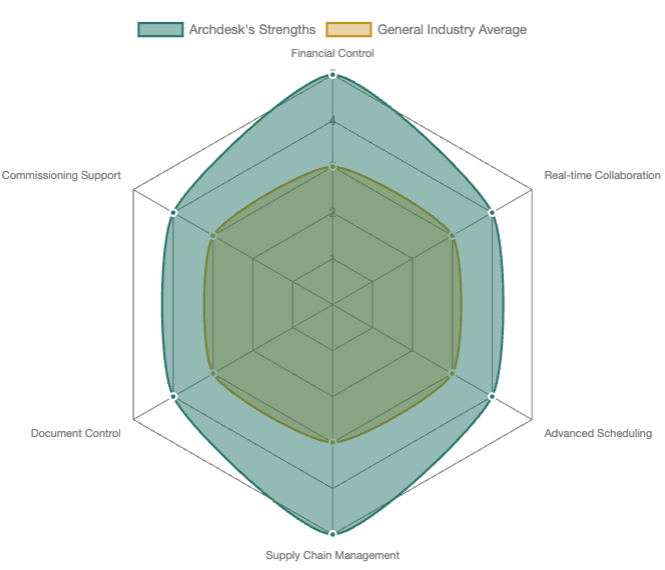
The radar chart above illustrates a comparative analysis of Archdesk's capabilities against a generalized industry average for construction management software in the data center sector. It highlights Archdesk's particular strengths in critical areas like financial control and supply chain management, essential for the demanding nature of these projects.
The Digital Transition: Embracing Integrated Workflows
The construction industry, particularly for complex projects like data centers, is moving rapidly towards digital integration. This means connecting various specialized tools and ensuring a smooth flow of information from design to handover.
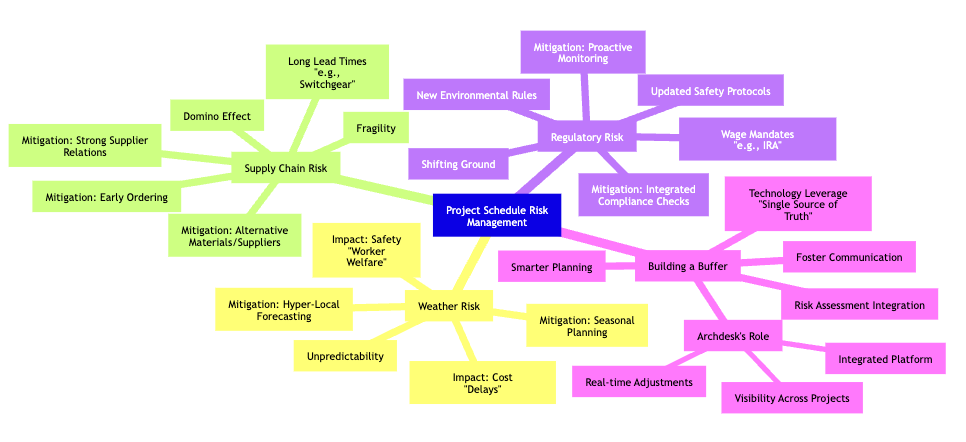
This mindmap illustrates the interconnected facets of data center project management, emphasizing how crucial each component is and how they all need to work together seamlessly. Effective construction management software provides a framework for integrating these diverse elements.
Bridging the Gaps with Specialized Tools
While Archdesk serves as a powerful core, it’s also designed to integrate with other specialized tools when needed. For instance, your Building Information Modeling (BIM) might be handled in platforms like Navisworks or ACC for clash detection and coordination. Site Augmented Reality (AR) tools, such as GAMMA AR or XYZ Reality, can be used to verify installations against design. Archdesk then anchors the critical decisions: who approved a change, what it costs, and how it impacts the schedule.
The handoff to Data Center Infrastructure Management (DCIM) platforms, like Sunbird, Nlyte, or Schneider’s EcoStruxure, is another crucial step. While construction teams don't directly use DCIM to build, they absolutely need a clean, accurate handover. Archdesk helps organize assets, submittals, Operations & Maintenance (O&M) manuals, and change histories, ensuring that your DCIM load is accurate from day one, preventing future headaches.
Regional Nuances in Data Center Construction
It’s also worth remembering that data center construction isn't a one-size-fits-all endeavor. Regional differences can significantly impact project dynamics:
- North America: Known for fast hyperscale cycles, strict commissioning sequences, and rigorous Authority Having Jurisdiction (AHJ) reviews. Robust cost forecasting, like that offered by Archdesk, is essential to keep draw schedules honest.
- Europe: Increasingly focused on sustainability reporting and Life Cycle Assessment (LCA) expectations. Centralizing documentation and evidence within your management platform becomes critical.
- GCC (Gulf Cooperation Council): Labor and logistics can be heavily influenced by extreme heat and local holidays. Flexible scheduling and precise delivery window management become even more vital here.
The Tangible Benefits: What It Means for Your Business
Ultimately, choosing the right software isn’t about picking the biggest name; it’s about finding a partner that truly fits the realities of your projects and the strategic needs of your business. For the intricate, fast-paced, and financially sensitive world of data center construction, you need a solution that provides both powerful project tools and unwavering financial control.
Imagine your team finishing a phase ahead of schedule because the software proactively flagged potential material delays, allowing you to adapt. That’s not just a happy accident; it’s the result of having the right setup. For employees, it translates to less paperwork, fewer lost documents, and less time wasted on miscommunications—more time actually building. For CEOs, it means peace of mind, seeing a clearer return on investment through reduced waste and, importantly, happier clients.
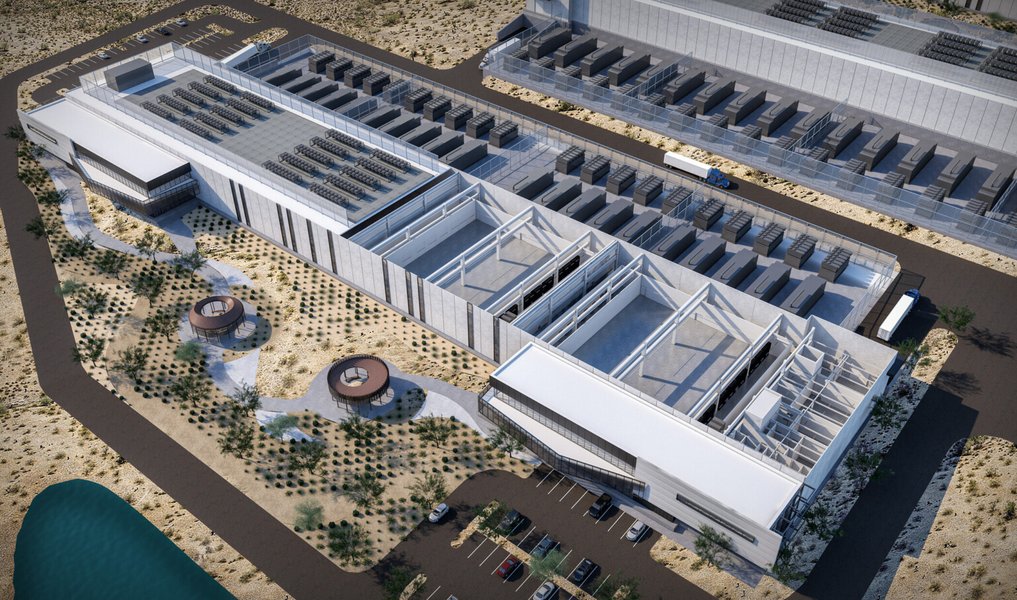
A modern data center design, emphasizing efficiency and scale.
A Practical Scenario
Consider a scenario: you're building a Tier 3 data center requiring two 40 MVA feeds, liquid cooling in specific halls, and prefabricated plant rooms. Archdesk helps you establish a detailed Work Breakdown Structure (WBS), maps long-lead items to your schedule, locks down budgets, and manages approvals. If a transformer delivery unexpectedly slips by three weeks, the platform doesn't just notify you; it automatically shifts dependent install windows, updates subcontractor packages, revises your financial forecast, and flags the potential impact on the owner. No drama, just clear cause and effect, enabling proactive decision-making.
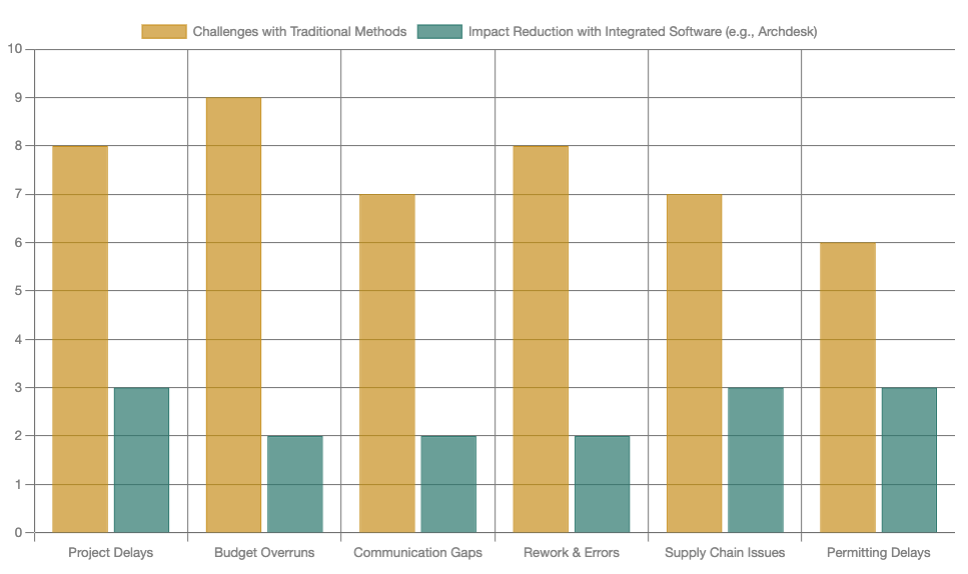
This bar chart illustrates how integrated construction management software like Archdesk can significantly reduce common challenges faced in data center construction, such as project delays, budget overruns, and communication gaps, compared to traditional management methods.
Key Features of Advanced Construction Management Software
To summarize the core capabilities, here's a table outlining the essential features for navigating the complexities of data center construction:
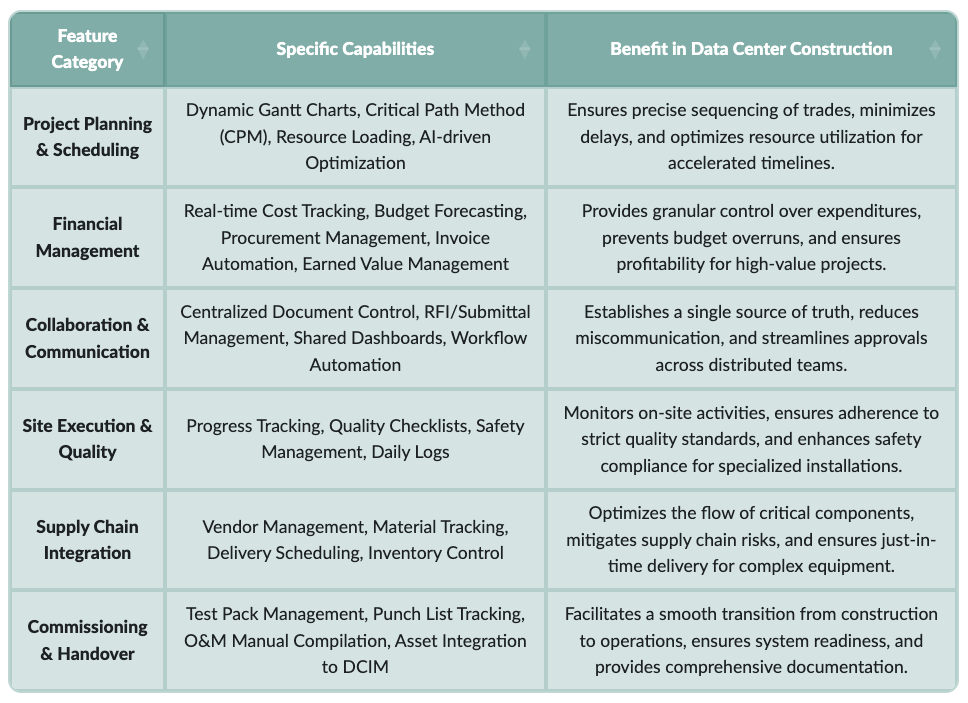
Staying Ahead in a Rapidly Evolving Landscape
Data center construction will only become more demanding. Trillions of dollars are being invested globally to keep pace with the accelerating demand driven by AI, cloud computing, and countless other digital advancements. So, having software that continuously adapts and provides insights is no longer optional; it’s a necessity. It’s about spotting opportunities before they turn into problems and guiding every project to a successful completion.
It’s truly amazing how a well-designed tool can transform chaos into something manageable. One executive once told me it felt like finally getting glasses after years of squinting—everything just sharpened up. That’s the kind of clarity and control Archdesk aims to deliver.
Frequently Asked Questions About Data Center Construction Management
What makes data center construction so challenging?
Data center construction is uniquely challenging due to its immense complexity, tight timelines, and the need for absolute precision in highly specialized trades like electrical, HVAC, and networking. A single error can lead to significant delays and budget overruns. These projects demand constant coordination, rigorous quality control, and careful management of global supply chains for critical, long-lead components.
How does construction management software help with data center projects?
Construction management software provides a centralized platform for real-time collaboration, financial control, and comprehensive project oversight. It streamlines scheduling, tracks costs, manages procurement, and facilitates document control, ensuring everyone has access to up-to-date information. This helps anticipate problems, optimize workflows, reduce errors, and ultimately deliver projects on time and within budget.
Why is financial control particularly important in data center construction?
Financial control is paramount in data center construction because of the large capital investments and the high cost of delays. Real-time cost tracking, accurate budget forecasting, and robust procurement management are crucial. They allow project leaders to understand the financial impact of changes immediately, make informed decisions, and maintain profitability in high-stakes environments.
Can specialized tools like BIM and DCIM integrate with a core management platform?
Absolutely. While core construction management platforms like Archdesk provide overarching control, they are designed to work seamlessly with specialized tools such as BIM (Building Information Modeling) for design coordination and DCIM (Data Center Infrastructure Management) for operational handover. The core platform serves as the central repository for project data, ensuring consistent information flow and accurate data for downstream systems.
How does Archdesk compare to other construction software solutions?
Archdesk distinguishes itself by offering a comprehensive business management platform that tightly integrates project management with financial control. While other solutions like Procore offer broad project tooling or Autodesk Construction Cloud excels in design integration, Archdesk focuses on providing a unified solution that links live project delivery to financial realities, making it particularly strong for managing the costs and complexities of data center projects without needing multiple disconnected systems.
Conclusion: Building Smarter, Not Just Faster
Building data centers is undoubtedly tough work. But with the right tools, it doesn't have to be a constant struggle. Software like Archdesk is specifically designed to alleviate some of that weight, providing the clarity and control you need to not just survive but truly thrive in this demanding market. It’s about building smarter, not merely faster. Having the right tools makes a profound difference, leading to fewer RFIs, cleaner handovers, and margins that stay exactly where you planned them. After all, your projects are literally building the future, and that’s a job worth doing right.
References
Get Started with Construction Management Software | Book Demo | ...
Construction Project Management Software | Archdesk
Construction Software for Main Contractors | Archdesk
The 15 Best Construction Management Software Tools in 2025 | Archdesk ...





